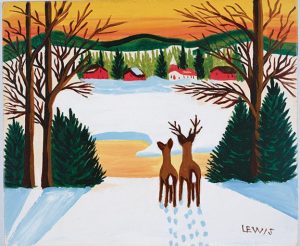![]()
Now revered for her contributions to the world of folk art, Maud Lewis certainly led a difficult and troubled life, through no fault of her own. The biopic Maudie tells her story in a straightforward and direct fashion, not unlike the woman herself. While there aren’t a whole lot of surprises, this is still a remarkably effective picture thanks to a winning performance from the film’s star.
 As the movie begins, Maud (Sally Hawkins) is living with her aunt (Gabrielle Rose) at the family home in Marshalltown, Nova Scotia. Having suffered from severe rheumatoid arthritis since childhood, she has joint problems and moves with a limp. Despite wanting independence, Maud is policed by family members who consider her disabled. After reading a want ad, she takes position for Everett Lewis (Ethan Hawke), one of the most ill-tempered, gruff and abusive personalities on the island. As the two live in a 10 foot by 12 foot cabin, Maud finds relief from her daily chores in simple painting that begins to attract attention far beyond the town.
As the movie begins, Maud (Sally Hawkins) is living with her aunt (Gabrielle Rose) at the family home in Marshalltown, Nova Scotia. Having suffered from severe rheumatoid arthritis since childhood, she has joint problems and moves with a limp. Despite wanting independence, Maud is policed by family members who consider her disabled. After reading a want ad, she takes position for Everett Lewis (Ethan Hawke), one of the most ill-tempered, gruff and abusive personalities on the island. As the two live in a 10 foot by 12 foot cabin, Maud finds relief from her daily chores in simple painting that begins to attract attention far beyond the town.
Unfortunately, while the scenery by the ocean may be picturesque, the life of the central character was an endurance test. Maud is continually treated terribly by family, and her new employer isn’t always a big improvement, essentially wanting little more than a maid and lover. This isn’t a pretty romance of two outcasts finding solace together. Subconsciously, their social position on the fringe of the community may have been what ultimately helped them relate and eventually form affection for one another, but viewers still see some ugliness in Everett along the way.
 As mentioned, Hawkins is impressive in the role. Her physical issues are subtly portrayed and never emphasized. And whether it comes to the woman describing her artistic style or dealing with the often tragic events in her life, she keeps it simple, understated and low-key, giving the woman an air of poise and pride despite the many hardships. All she wants is to live life on her own terms and she quietly carries on in order to make that happen… even if the attention gained and new position as family breadwinner (at least, earning enough to keep the pair functioning) ultimately leads to some conflict within the marriage. There aren’t any revelatory insights about the character or art, but then again, heavy analysis of the simple folk art would be overreaching.
As mentioned, Hawkins is impressive in the role. Her physical issues are subtly portrayed and never emphasized. And whether it comes to the woman describing her artistic style or dealing with the often tragic events in her life, she keeps it simple, understated and low-key, giving the woman an air of poise and pride despite the many hardships. All she wants is to live life on her own terms and she quietly carries on in order to make that happen… even if the attention gained and new position as family breadwinner (at least, earning enough to keep the pair functioning) ultimately leads to some conflict within the marriage. There aren’t any revelatory insights about the character or art, but then again, heavy analysis of the simple folk art would be overreaching.
 Hawke has a challenging part to play as well. His character is drawn in shades of grey, but the actor still manages to maintain our interest. The last act contains some impressive moments as well. Understated yet incredibly affecting, a few minutes towards the end are played out through body language and almost entirely without dialogue, yet manage to be all the more moving, to a large degree because of the silence.
Hawke has a challenging part to play as well. His character is drawn in shades of grey, but the actor still manages to maintain our interest. The last act contains some impressive moments as well. Understated yet incredibly affecting, a few minutes towards the end are played out through body language and almost entirely without dialogue, yet manage to be all the more moving, to a large degree because of the silence.
This is a leisurely-paced film and one where it may take some time to get used to cadence of the characters. Viewers may also be frustrated by many grueling situations that the lead is forced to endure without any reprisal. Alas, the 30s and 40s were a different era and those were the conditions and general treatment of this woman during the time period. It makes it all the more amazing that her work was filled with such color and happiness. In the end, Maudie serves as a rewarding and informative testament that should help to cement her legacy.


